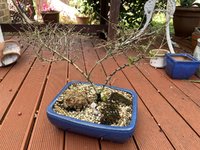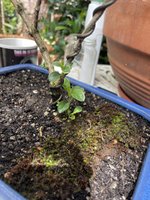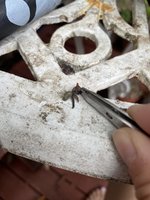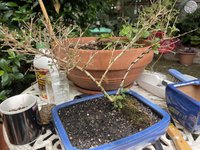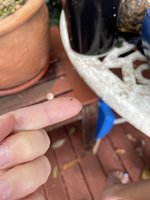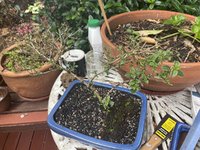TPM
Seedling
In November last year I was gifted a Serissa - while the tree is beautiful and I have been casually interested in bonsai as an art form, it is my first ever tree (and one I never would have gotten myself). It is extremely temperamental, the first month or so in my care it acclimatised well and took off growing and flowering out of control, I even had to prune back some shoots and suckers that were taking off too fast. I keep it out doors where it gets filtered sun during the day, only water so the soil is damp - very bad of me but I haven't been fertilising as I couldn't find one that suited what was recommended online.
However, my country has been hit hard by La Niña this past year, and as late November and December hit, the weather turned horrible. It went down hill after one particularly windy and rainy day where I was at work, by the time I got home it was well into the evening and the tree looked completely windburnt and had gotten more rain than it ever should where it is situated. The weather would do this for a week at a time which meant I was moving the tree around to keep it out of the wind and stormy weather, there was very little natural sunlight. Indoors isn't really an option, my home is very cold and dark, even though it is currently summer. It never really recovered from this and stopped flowering, then the leaves all yellowed, then dried up brown and finally dropped about 1-2 weeks ago. The soil was moist this whole time but I reduced watering (partially because I fear it died, also because I didn't want rot on the off chance it would live, honestly I barely watered for a fortnight and let some humid afternoon showers do the heavy lifting), but the weather improved remarkably this February and I returned it to its original spot. I must emphasise - there was not one single leaf on this tree, I even noticed a few ants near/on the tree and began preparing for war (no nest in the soil, though there is one nearby in the garden. I keep the tree on a table, and I have a few super tiny garden spiders recruited for aphid control - they get on well with the potted plants in the yard, though I generally remove their webs when they get too confident).
In the last week I noticed new leaves growing on the inner most branches, and even on the trunk, plus two new suckers. In a matter of days I'm really thinking it will come back to life now that it has light and humid warmth again. I need to know where to go from here - watering, feeding, pruning. It has a lot of really dead looking outer branches, should I prune them all back? They have no green whatsoever and are very dry/brittle looking. On feeding - the internet has recommended a balanced NPK, but every supply shop I have visited has never heard of such a product, and I can't find a reasonably located bonsai store. The closest I can find to 'balanced' is Seasol, has anyone used this before? How long should I wait before fertilising, particularly given I'm going into autumn down here? Also, the fullest and greenest of the new growth doesn't appear to be variegated as the leaves originally were before they dropped, is this a concern? Perhaps they're just new and will develop the pattern. Sorry for the length of the post!
However, my country has been hit hard by La Niña this past year, and as late November and December hit, the weather turned horrible. It went down hill after one particularly windy and rainy day where I was at work, by the time I got home it was well into the evening and the tree looked completely windburnt and had gotten more rain than it ever should where it is situated. The weather would do this for a week at a time which meant I was moving the tree around to keep it out of the wind and stormy weather, there was very little natural sunlight. Indoors isn't really an option, my home is very cold and dark, even though it is currently summer. It never really recovered from this and stopped flowering, then the leaves all yellowed, then dried up brown and finally dropped about 1-2 weeks ago. The soil was moist this whole time but I reduced watering (partially because I fear it died, also because I didn't want rot on the off chance it would live, honestly I barely watered for a fortnight and let some humid afternoon showers do the heavy lifting), but the weather improved remarkably this February and I returned it to its original spot. I must emphasise - there was not one single leaf on this tree, I even noticed a few ants near/on the tree and began preparing for war (no nest in the soil, though there is one nearby in the garden. I keep the tree on a table, and I have a few super tiny garden spiders recruited for aphid control - they get on well with the potted plants in the yard, though I generally remove their webs when they get too confident).
In the last week I noticed new leaves growing on the inner most branches, and even on the trunk, plus two new suckers. In a matter of days I'm really thinking it will come back to life now that it has light and humid warmth again. I need to know where to go from here - watering, feeding, pruning. It has a lot of really dead looking outer branches, should I prune them all back? They have no green whatsoever and are very dry/brittle looking. On feeding - the internet has recommended a balanced NPK, but every supply shop I have visited has never heard of such a product, and I can't find a reasonably located bonsai store. The closest I can find to 'balanced' is Seasol, has anyone used this before? How long should I wait before fertilising, particularly given I'm going into autumn down here? Also, the fullest and greenest of the new growth doesn't appear to be variegated as the leaves originally were before they dropped, is this a concern? Perhaps they're just new and will develop the pattern. Sorry for the length of the post!

